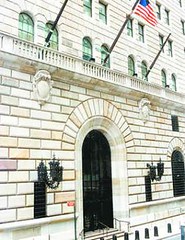
PREV ARTICLE
NEXT ARTICLE
FULL ISSUE
PREV FULL ISSUE
ARTICLE REVIEWS NEW YORK FEDERAL RESERVE BANK TOUR An article from the Los Angeles Times (published in several other papers as well) describes a recent tour of the Federal Reserve Bank of New York and the American Numismatic Society's exhibit there. -Editor  The economic crisis was palpable throughout Manhattan's financial district, yet the atmosphere inside the Federal Reserve Bank of New York was eerily serene, almost like a church. The economic crisis was palpable throughout Manhattan's financial district, yet the atmosphere inside the Federal Reserve Bank of New York was eerily serene, almost like a church. It was fitting, for money is worshiped at "the Fed," as the central bank is known, and a visit to the nation's central bank feels like a trip to capitalism's cathedral. Instead of the bodies of saints, the bank's catacombs hold about $180 billion in gold bars - more gold than is stowed in Fort Knox, and almost one-quarter of the world's supply. As New York tourist destinations go, the historic landmark on Liberty Street attracts a fraction of the visitors who flock to the city's more famous spots. The bank's free 30-minute guided tour won't give you a complete grasp of the nuances of reserve requirements and the difference between real and nominal gross domestic product. Yet you will leave knowing a lot more about money than when you walked in, and some of it will be more enjoyable than a college economics class. The first thing you come across is what looks like an unguarded gold bar, slowly spinning with the invitation, "Help yourself!" But the bar turns out to be a hologram, your hand passing through it like fog. Although the tour is largely humorless and strict (you're instructed not to take pictures or notes in the massive subterranean gold vault), the displays in the lobby - a stunning foyer adorned with designer Samuel Yellin's 200 tons of ornate wrought ironwork - are surprisingly fun, even as they're informative. Used banknotes are no longer burned (it's not green to send up green in smoke) but shredded, and there's $48 million in minced $100 bills in one display, part of the $105 million in paper currency cut up daily. Not far away, an exhibit about counterfeiting presents some really good fakes; only with an oversized magnifying glass that slides over both the real and the ersatz bills (along with what-to-look-for pointers in the exhibit) can you spot the impostor $5, $10 and $20 bills. Hundreds of rare coins and currency to illustrate the history of money, grouped by era and region, are on loan to the bank from the American Numismatic Society. The highlights include a shekel from 109 B.C., and the most valuable coin ever sold, a U.S. 1933 Double Eagle that fetched nearly $8 million in a recent auction. To read the complete article, see: A cathedral of capitalism (http://www.philly.com/philly/travel/20090111_A_cathedral_of_capitalism.html) Wayne Homren, Editor The Numismatic Bibliomania Society is a non-profit organization promoting numismatic literature. See our web site at coinbooks.org. To submit items for publication in The E-Sylum, write to the Editor at this address: whomren@gmail.com To subscribe go to: https://my.binhost.com/lists/listinfo/esylum All Rights Reserved. NBS Home Page Contact the NBS webmaster 
|